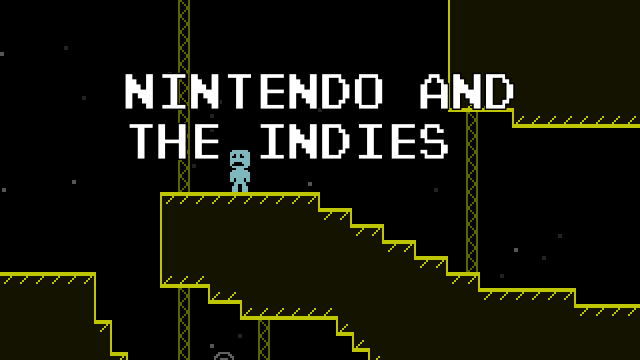
Independent video games. The term alone has become somewhat of a buzz word in recent times, bringing with it certain expectations and flavor. Indie games have even become a sort of loose genre in and of themselves. They are bigger than ever before, and their success and influence is only going to increase in the years to come. This is in no small part due to the advent of digital distribution– it has changed the way games can be sold and produced forever. Some games are good and some are bad, but one would be daft to deny the potential of indie games. Small teams have crafted some truly incredible games, and in the current generation we have seen console manufacturers reach out and try to get a piece of the indie action. So what’s Nintendo’s role in all of this?
Nintendo’s exact opinion on indie games is actually a bit difficult to ascertain. At one point, Nintendo said “we are not looking to do business today with the garage developer,” yet on the other hand Nintendo has also stated that “we embrace that kind of independent spirit and it’s ultimately the most innovative content that will rise to the top.” So which is it? The more I look at Nintendo’s approach to independent developers, the more inconsistent it seems. Nintendo has done some great services to indie games, yet at the same time the company has done many things to discourage them.
Let’s start with the positives. When Nintendo finds an indie game that it really likes, it throws all of its support behind it. Let’s look at some of the biggest indie hits on Nintendo consoles: these are games like World of Goo, Cave Story, the Bit.Trip series, Mutant Mudds, and VVVVVV. All of these are great games that have been critically acclaimed and have done well on Nintendo’s digital platforms. By partnering up with indie studios like 2D Boy, Nicalis, and Gaijin, Nintendo has been able to prove that they can support indie games.
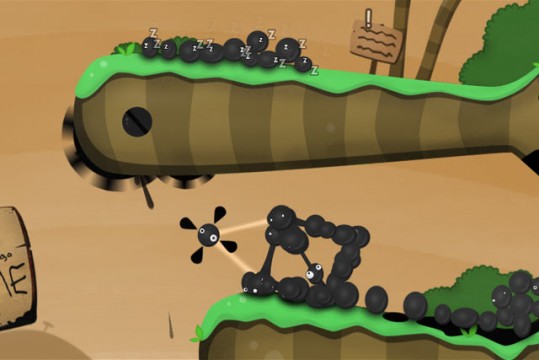
Wii was a great platform for World of Goo and And Yet it Moves. Games like those are greatly improved by introducing aspects of control that can only be done on Wii. Mutant Mudds was also able to show off the features of Nintendo 3DS quite nicely. Indie games can not only find a bigger audience through Nintendo platforms, they can utilize the hardware and become even better from being distributed by Nintendo.
But the amount of quality indie titles on Nintendo’s digital platforms is not very high. Compared to other digital platforms like Xbox Live Arcade, PlayStation Network, Steam, and the Android and iOS app stores, Nintendo fails to bring much variety. One can argue that this is because of Nintendo’s high standards for quality (which I’m going to touch on later), but this argument fails to account for the fact that the WiiWare and DSiWare stores are filled with shovelware. Another argument would be that many indie developers have to enter into contracts with Microsoft and Sony that prevent them from distributing their games with Nintendo. This is very true in many cases, but there have also been many instances in which developers who sought out Nintendo were turned down or unable to meet its requirements.
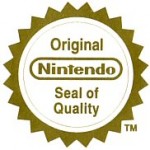
But before I look at that, I think we need to take a step back in time and look at Nintendo’s history with quality control for third parties. Anyone familiar with the history of video games should know of the notorious video game crash of the early 1980s. Hundreds of low quality games saturated the market, which caused the industry to take a nosedive. Nintendo ended up rescuing the gaming industry with the Nintendo Entertainment System. It developed a new system in order to control the quality of video games released on its platform: each game made by a third party developer had to go through a process and be given a Nintendo Seal of Quality. This practice worked quite well for Nintendo and it has continued it throughout the years. But what does this have to do with indie developers? A good bit, actually.
An indie developer wants to get through as few hoops as possible when distributing their game. This is why indie games are so prevalent on computers and smartphones. Platforms like Steam and the Android and iOS App Stores are fairly open and have few barriers for entry. This is in contrast to console manufacturers, which often have strict guidelines and requirements that developers must follow in order to be allowed on. PSN and XBLA have their own sets of rules, but Nintendo’s requirements (especially on WiiWare) seem to be especially discouraging to indies. The legacy of the Seal of Quality and Nintendo’s guidelines for third parties has led several indie developers to avoid Nintendo entirely.
Beamdog is not an indie developer, but last month it proclaimed that it would not be working with Nintendo anymore because of the limitations of the WiiWare platform. The main reasons Beamdog ditched Nintendo included WiiWare’s 40MB limitation for games, a rule that keeps developers from getting any profit until a game has sold 6000 copies, a lack of promotion and visibility for WiiWare titles, and a long certification process. If Beamdog– a company that works for the well-known studio Interplay– has difficulty working with Nintendo, then tiny indies would have an even tougher time.
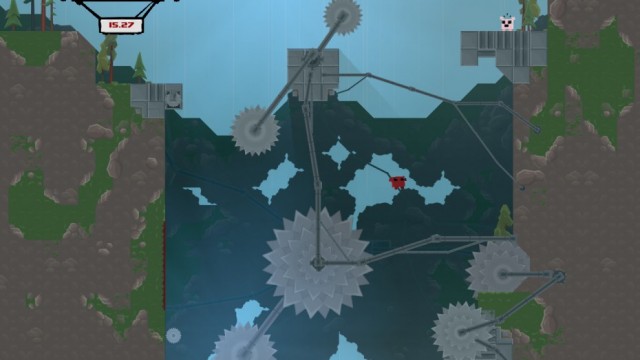
Oh, Meat Boy. We hardly knew ya.
These limitations that Nintendo imposes on WiiWare have caused several well-known and critically acclaimed indie studios to completely pass on a release for the platform. La-Mulana for WiiWare: canceled. Machinarium for WiiWare: canceled. Super Meat Boy for WiiWare: canceled! Seeing a trend here? As a console manufacturer, Nintendo really ought to be giving developers reasons to want to come onto its platform. It seems that Nintendo reserves its best attention for exclusive games. World of Goo, Cave Story, and the Bit.Trip games are the biggest indie games on Nintendo systems, and Nintendo alone has distributed them on consoles. Nintendo doesn’t seem like it wants to reach out a hand to developers who are also interested in dealing with competitors like Sony and Microsoft. This is something Nintendo just needs to get over.
So, what else could Nintendo do differently? The 3DS eShop is taking many steps in the right direction. We have already had several great indie titles on the platform within its first year, titles like Mutant Mudds, Colors! 3D and VVVVVV. The eShop also has more exposure for its titles than WiiWare or DSiWare. The top games are featured on the shop’s main page, and there is a comprehensive rating system for each game. eShop games are pretty cheap too, which encourages more sales.
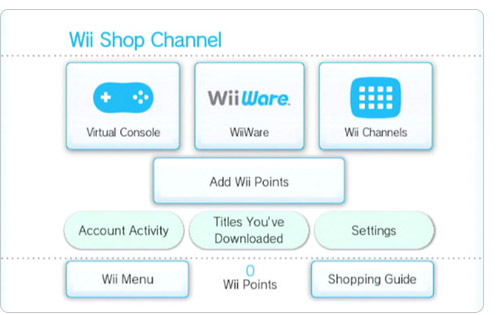
The Wii Shop Channel is difficult to navigate and positively boring to look at.
While the eShop is relatively kosher for indies, WiiWare is just terrible and beyond saving. Here are some things Nintendo needs to improve when it launches the Wii U digital platform:
1. Ditch the 40MB limit. I understand that having a space limit saves time and money, but 40MB is paltry. However I think this one is a given. Nintendo is set to start distributing retail titles digitally, and obviously those games will be larger than 40MB.
2. Stop the strict certification processes. It’s important for a company like Nintendo to maintain quality control, but there comes a point where the control discourages developers. I don’t think that Nintendo should be as lax as the iOS App Store (otherwise we would get thousands of clones and scams), but it needs to be able to give indies a stress-free platform to develop on.
3. Promotion, promotion, promotion. WiiWare has little to no promotion for games. The 3DS eShop has decent promotion for the games on it, but it could be better. Nintendo needs to work with developers to help promote games. We should get something beyond a weekly Nintendo email. We need something like a rotation of new games on the Wii U home screen. Or what if Nintendo had a service where new demos of digital games were sent to you automatically? If games don’t get exposure, people don’t buy them. It’s as simple as that. Many games on Nintendo’s digital platforms don’t sell too well, but an increase in promotion on the Wii U interface could change that.
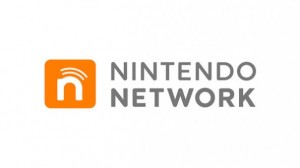
Will the new Nintendo Network improve Nintendo’s digital distribution?
Wii U is looking to be an incredibly interesting platform, and if Nintendo makes the right moves, it can be a place where independent developers thrive. I don’t think that the barriers that Nintendo has against indie developers are necessarily intentional; they are products of Nintendo’s history of content control and relationships with third party developers. Nintendo can change its reputation with a few adjustments and some attempts to better accommodate independent games. The indie developers of today could very well end up becoming the great faces of gaming in the future. If Nintendo can nurture more independent games, it can help expand not only its own business, but encourage more people to start creating video games.




 ShareThis
ShareThis







And we missed the binding of isaac too.